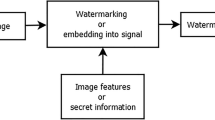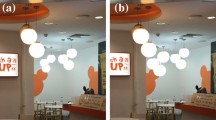Abstract
Digital image fraudulent has become a very dangerous problem because of the rapidly growing media editing software. The information on the digital image can be easily replaced by fake information. Several cybercrime activities are attempted by hacking the digital images. Due to the presence of various kinds of media editing software, the digital image authenticity is very much significant. Nowadays, the detection of the manipulated images and localization of the manipulated regions are important issues. Many efforts have been made over the past decade to detect the tampered images and localization of the tampered regions with high accuracy based on some specially designed mechanisms. This paper presents a detailed survey of existing approaches for detecting tampered images and localization of the tampered regions.



Similar content being viewed by others
References
Ahmed, Belal, and T Aaron Gulliver (2020). “Image splicing detection using mask-RCNN.” Signal, Image and Video Processing: 1–8
Alahmadi A et al (2017) Passive detection of image forgery using DCT and local binary pattern. SIViP 11(1):81–88
Alkawaz MH, Sulong G, Saba T, Rehman A (2018) Detection of copy-move image forgery based on discrete cosine transform. Neural Comput & Applic 30(1):183–192
Ardizzone, Edoardo, Alessandro Bruno, and Giuseppe Mazzola (2010). “Detecting multiple copies in tampered images.” 2010 IEEE International Conference on Image Processing. IEEE
Alahmadi AA, Hussain M, Aboalsamh H, Muhammad G, Bebis G (2013). Splicing image forgery detection based on DCT and local binary pattern, pp 253–256
Beier, T, Neely, S (1992). Feature-based image metamorphosis. In: Proceedings of the 19th Annual Conference on Computer Graphics and Interactive Techniques, SIGGRAPH 1992, pp. 35–42. ACM, New York
Bilmes, J (1997). “A gentle tutorial of the EM algorithm and its application to parameter estimation for Gaussian mixture and hidden Markov models,” ICSI, Tech. Rep. TR-97-021
Bay H, Tuytelaars T, Van GL (2006) SURF: speeded up robust features. Eur Conf Comput Vis 5:404–417
Bayar, Belhassen, and Matthew C. Stamm (2016). “A deep learning approach to universal image manipulation detection using a new convolutional layer.” Proceedings of the 4th ACM Workshop on Information Hiding and Multimedia Security. ACM
Barnes CE, Shechtman AF, Goldman D (2009) PatchMatch: A randomized correspondence algorithm for structural image editing. ACM Trans. Graph 28(3):24:1–24:11
Chang C-C, Lin C-J (2011) LIBSVM: a library for support vector machines. ACM Trans. Intelligent Systems and Technology 2(3):27:1–27:27
Cao Y, Gao T, Fan L, Yang Q (2012) A robust detection algorithm for copy-move forgery in digital images. Forensic SciInt 214(1–3):33–34
Cortes C, Vapnik V (1995) Support-vector networks. Mach Learn 20(3):273–297
Chen H, Yang X, Lyu Y (2020) Copy-move forgery detection based on Keypoint clustering and similar neighborhood search algorithm. IEEE Access 8:36863–36875
Cozzolino. D, D Gragnaniello, and L Verdoliva (2014). “Image forgery localization through the fusion of camera-based, feature-based and pixelbased techniques,” in Proc. IEEE Int. Conf. Image Process., Oct. 2014,pp. 5302–5306
Di H, Caifeng S (2011) Local binary patterns and its application to facial image analysis: a survey. IEEE Trans Syst Man Cybern 41(6):765–781
Guo Y, Cao X, Zhang W, Wang R (2018) Fake colorized image detection. IEEE Transactions on Information Forensics and Security 13(8):1932–1944
Girshick, R (2015). Fast R-CNN. In: Proceedings of the IEEE International Conference on Computer Vision. Santiago, Chile, Dec 13–16
Gaborini. L, P Bestagini, S Milani, M Tagliasacchi, and S Tubaro (2014).“Multi-clue image tampering localization,” in Proc. IEEE Int. Workshop Inf. Forensics Secur., Dec. 2014, pp. 125–130
He K, Sun J, Tang X (2011) Single image haze removal using dark channel prior. IEEE Trans Pattern Analysis and Machine Intelligence 33(12):2341–2353
Hussain, M, Wajid, SK, Elzaart, A, Berbar, M. (2011). A comparison of SVM kernel functions for breast cancer detection. In: Proceedings of the 2011 Eighth International Conference on Computer Graphics, Imaging and Visualization (CGIV 2011), Singapore, pp. 145–150
He, K, et al. (2017). Mask R-CNN. In: Proceedings of the IEEE International Conference on Computer Vision. Honolulu, HI, USA, Jul 22–25
He, K, et al.(2016). Deep residual learning for image recognition. In: Proceedings of the IEEE Conference on Computer Vision and Pattern Recognition. Las Vegas, NV, USA, Jun 26–Jul 1
Hashmi MF, Anand V, Keskar AG (2014). Copy-move image forgery detection using an efficient and robust method combining un-decimated wavelet transform and scale invariant feature transform, ELSEVIER, AASRI Conf. Circuit Signal Process., pp. 84–91
Hu W-C, Chen W-H, Huang D-Y, Yang C-Y (2016) Effective image forgery detection of tampered foreground or background image based on image watermarking and alpha mattes. Multimed Tools Appl 75(6):3495–3516
Hinton, GE, N Sriv astava, A Krizhevsky, I Sutskever, and RR Salakhutdinov (2012). Improving neural networks by preventing co-adaptation of feature detectors. arXiv preprint arXiv:1207.0580
Kim C, Shin D, Yang C-N (2018) Self-embedding fragile watermarking scheme to restoration of a tampered image using AMBTC. Pers Ubiquit Comput 22(1):11–22
Kohale T, Chede SD and Lakhe PR (2015). “Forgery of Copy Move Image Detection Technique by Integrating Block and Feature Based Method.” International Journal of Advanced Research in Computer and Communication Engineering Vol. 4, Issue 1, January
King DE (2009) Dlib-ml: a machine learning toolkit. J Mach Learn Res 10:1755–1758
Kazemi, V, Sullivan, J (2014). One millisecond face alignment with an ensemble of regression trees. In: Proceedings of the 2014 IEEE Conference on Computer Vision and Pattern Recognition. CVPR 2014, Computer Society, pp. 1867–1874. IEEE, Washington, DC
Kumar S, Nagori S (2017) Key-point based copy-move forgery detection in digital images. Journal of Statistics and Management Systems 20(4):611–621
Krizhevsky, A I Sutskever, and GE Hinton (2012). Imagenet classification with deep convolutional neural networks. In Advances in neural information processing systems, pages 1097{1105
Kumar, Manoj, Sangeet Srivastava, and Nafees Uddin. “Forgery detection using multiple light sources for synthetic images.” Australian Journal of Forensic Sciences (2017): 1–8
Laouamer L, Tayan O (2018) Performance evaluation of a document image watermarking approach with enhanced tamper localization and recovery. IEEE Access 6:26144–26166
Li J et al (2015) Segmentation-based image copy-move forgery detection scheme. IEEE Transactions on Information Forensics and Security 10(3):507–518
Lee BB, Pokorny J (1990) Luminance and chromatic modulation sensitivity of macaque ganglion cells and human observers. JOSA A 7:2223–2236
Li Y, Zhou J (2019) Fast and effective image copy-move forgery detection via hierarchical feature point matching. IEEE Trans. Inf. Forensics Security 14(5):13071322
Lowe DG (2004) Distinctive image features from scale-invariant keypoints. International journal of computer vision60 2:91–110
Leutenegger S, Chli M (2011). BRISK: Binary Robust Invariant Scalable Keypoints, IEEE int. Conf. Comp. Vis., pp 2548–2555
Li H, Luo W, Qiu X, Huang J (2017) Image forgery localization via integrating tampering possibility maps. IEEE Transactions on Information Forensics and Security 12(5):1240–1252
Neubert T (2017) Face morphing detection: an approach based on image degradation analysis. International Workshop on Digital Watermarking, Springer, Cham
Obara Y, Niwa Y, Wada S (2017) Detection and Identification of Image Manipulation Based on Reversible Histogram Shift. Electronics and Communications in Japan 100.9:13–22
Ojala T, Pietikainen M, Maenpaa T (2002) Multiresolution grayscale and rotation invariant texture classification with local binary patterns. IEEE Trans on Pattern Analysis and Machine Intelligence 24(7):971–987
Prakash CS et al (2018) Keypoint-based passive method for image manipulation detection. Cogent Engineering 5.1:1523346
Rao, Y, Ni, J (2016). A deep learning approach to detection of splicing and copy-move forgeries in images. In: Proceedings of the IEEE International Workshop on Information Forensics and Security. Abu Dhabi, UAE, Dec 4–7
Ren S, He K, Girshick R, Sun J (2016) Faster R-CNN: towards real-time object detection with region proposal networks. IEEE Trans Pattern Anal Mach Intell 39(6):1137–1149
Rublee E, Rabaud V, Konolige K,Bradski G (2011). ORB: an efficient alternative to SIFT or SURF, international conference on computer vision, Barcelona, Nov. 6-13, pp. 2564–257
Seibold, Clemens, et al. (2017). “Detection of face morphing attacks by deep learning.” International Workshop on Digital Watermarking. Springer, Cham
Singh D, Singh SK (2016) Effective self-embedding watermarking scheme for image tampered detection and localization with recovery capability. J Vis Commun Image Represent 38:775–789
Sundaram Meenakshi and Nandini, C. n.d.. “Image retouching and it's detection - a survey” International Journal of Research in Engineering and Technology eISSN: 2319–1163 | pISSN: 2321–7308
Sundaram A Meenakshi, and C Nandini (2017). “ASRD: Algorithm for Spliced Region Detection in Digital Image Forensics.” Computer Science On-line Conference. Springer, Cham
Su B, Kaizhen Z (2012). Detection of Copy Forgery in Digital Images Based on LPP-SIFT., Int. Conf. Ind. Control Electron. Eng., pp. 1773–1776
Saleh SQ, Hussain M, Muhammad G, Bebis G (2013) Evaluation of image forgery detection using multi-scale weber local descriptors. Proceedings International Symposium on Advances in Visual Computing, In, pp 416–424
Shi Z, Shen X, Kang H, Lv Y (2018) Image manipulation detection and localization based on the dual-domain convolutional neural networks. IEEE Access 6:76437–76453
Toldo. R and A Fusiello (2008). “Robust multiple structures estimation with J-Linkage,” in Proc. Eur. Conf. Comput. Vision., Berlin, pp. 537547
Vedaldi, A and B. Fulkerson (2008). “VLFeat: An open and portable library of computer vision algorithms,” http://www.vlfeat.org/
Wu M-L, Fahn C-S, Chen Y-F (2017) Image-format-independent tampered image detection based on overlapping concurrent directional patterns and neural networks. Appl Intell 47(2):347–361
Williams D, Hinton G (1986) Learning representations by back propagating errors. Nature 323:533–536
Yang, Y, W Ren, Y Guo, R Wang and X Cao (2017). “Image deblurring via extreme channels prior,” in Procs. IEEE Int. Conf. Comp. Vision and Pattern Recognition (CVPR), Accepted
Zhang G, Huang X (2005) Boosting local binary pattern (LBP)-based face recognition. Adv Biometr Person Authent 3338:179–186
Zhang Y, Zhao C, Pi Y, Li S (2012). Revealing image splicing forgery using local binary patterns of DCT coefficients. In: Proceedings International Conference on Communications, Signal Processing, and Systems, pp. 181–189
Zhang, Y, LL Win, J Goh, and VL Thing (2016). “Image region forgery detection: A deep learning approach,” in Proc. Singapore Cyber-Secur. Conf. (SG-CRC), pp. 111
Zhang, Ying, and Vrizlynn LL Thing (2018). “A semi-feature learning approach for tampered region localization across multi-format images.” Multimedia Tools and Applications 1–26
Author information
Authors and Affiliations
Corresponding author
Additional information
Publisher’s note
Springer Nature remains neutral with regard to jurisdictional claims in published maps and institutional affiliations.
Rights and permissions
About this article
Cite this article
Anbu, T., Joe, M.M. & Murugeswari, G. A comprehensive survey of detecting tampered images and localization of the tampered region. Multimed Tools Appl 80, 2713–2751 (2021). https://doi.org/10.1007/s11042-020-09585-z
Received:
Revised:
Accepted:
Published:
Issue Date:
DOI: https://doi.org/10.1007/s11042-020-09585-z




